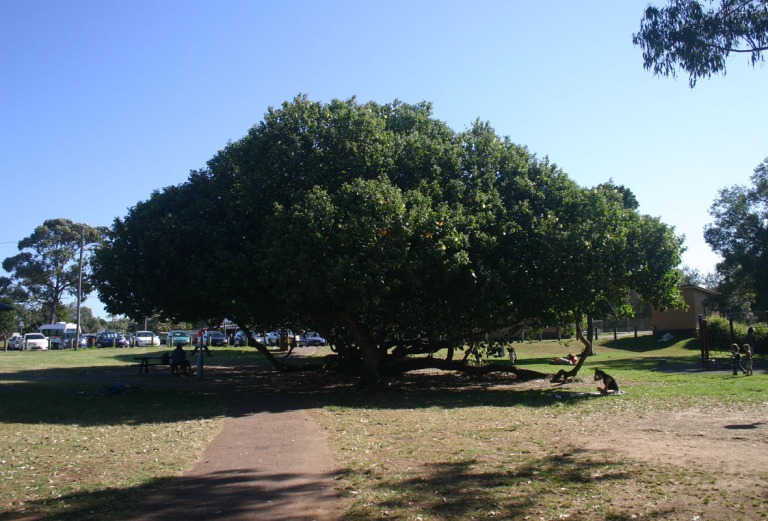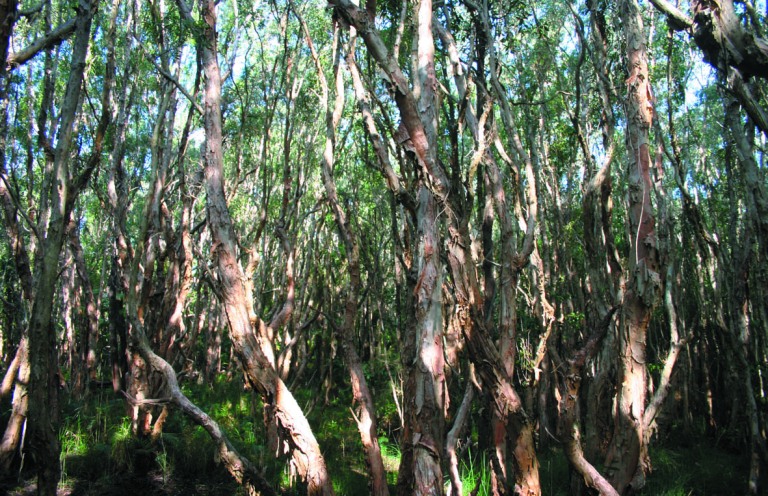

Byron Bay is often promoted in tourist literature as a peaceful hippy-mecca, but its population of over 9,000 can often be swamped under the seasonal influxes of tourists. Within the town centre the sounds of cars, pedestrians, buskers, and shop music sometimes overwhelm its small space. Ironically it becomes necessary to find somewhere to escape from the mass of peace-seekers.
Aside from its beaches Byron Bay’s parks lack an element of soundscape planning. Areas which have been designated to boost human enjoyment are compromised by their proximity to traffic, while sounds which may be desireable in some contexts, such as amplified music, often dominate the spaces where people go to mentally rejuvenate.


In 2000 Bohme argued that urban and landscape architects should take auditory perception into account. The perceptions of all senses should be dealt with to the same degree and the visual should not be favoured … urban and landscape planners and designers should create sonic environments which form part of their context over both time and space, (Acoustic Atmospheres: a contribution to the study of ecological aesthetics. Soundscape: the Journal of Acoustic Ecology 1, 2000)
A considerable amount of research has focussed on the development of visual aesthetics in urban environments however less research has investigated the relationship between our auditory sense and public space. The monotonous drone of industrial noise that prevails in many public areas disrupts our sense of psychological ease and hence contradicts one of the principles of public space. This is where the acoustic importance of Cumbebin Wetland becomes significant.


Just a few minutes walk from Byron Bay’s town centre, Cumbebin Wetland is an oasis of desirable hi-fi sound. Traffic noise from the nearby road is buffered by the wetland’s melaluka trees. In its place the sounds of birds, crickets, cicadas, bats and frogs provide a welcome relief from the sonic overload outside. It is to Byron Bay’s credit that this park has been zoned for both wildlife rehabilitation and public access. Rare species of frogs and bats have been given a relatively stable habitat, and the local community now has a place to escape from the industrial sounds of the town-centre. The auditory benefits of Cumbebin Wetland are therefore two-fold: it provides a pleasant acoustic space whilst retaining the integrity of Byron Bay’s natural soundscape.
In 2003 the US National Park Service stated that the preservation and restoration of diminishing natural sound environments or soundscapes has become a foremost challenge in the protection of park resources … Natural sounds are part of the special places we preserve. Rustling winds in canyons and the rush of waters in the rivers are the heartbeat and breadth of some of our most valuable resources (Sound~Waves: a Soundscape Newsletter).
In this era of rapid population growth it is easy for councils to favour utilitarian styles of town-design over the more subtle components of acoustic space. I hope that town-planners will change this approach and begin to consider the value of an area’s natural sound resources within their future urban designs.
As someone who specialises in recording and archiving urban street sounds I come at this post from two angles. Your first sound piece is of interest to me because it represents the sounds of the place … however unwelcome they may be in relation to the context that you describe.
Amplified music in public spaces and out of context is always unwelcome to my ear.
Your final sound piece is as delicious as always. You capture natural sounds beautifully. I completely agree with you that acoustic ecology features far less in urban design than it should. I do believe though that the debate is gaining traction so let’s hang in there and keep promoting the cause.
LikeLike
Yes, a town wouldn’t be an urban space without its individual street sounds. My issue is related more with finding spaces within towns that are “zoned” with acoustics in mind.
LikeLike
I’m amazed that the Cumbebin Wetland recording is made so close by the town center!
Just last weekend I was reminded of all the disturbing noises surrounding you when being in the forests of southern Sweden. As I’ll move north soon I felt like I wanted to get some audioportraits for future listening so I went out to do some nature recordings here in Skåne. The recordings I brought home where littered by noises from chain saws, aeroplanes, quads, cars, trucks and what not despite my efforts to get away from surrounding traffic. This time I actually welcomed the drones as I wanted the recordings to be descriptive of the soundscapes in this part of Sweden, but I’ve lost count of the numerous times I’ve cursed the sonic spill from civilization while doing recordings here.
LikeLike
Thanks for the detailed feedback! Yes, the wetland is a very special place, so rich in sonic diversity and so effective in creating a cushioning effect from the outside world.
I still really enjoy listening to the blend between the natural and the industrial, so I’m looking forward to listening to your recordings. My fear is that we are losing these quiet spaces, and what is replacing them is homogenised sound that is often very invasive. The environment is suffering, but so too is our quality of life.
LikeLike
Really interesting post, it echoes my own feelings about ‘relaxing’ towns or other areas that people often use to ‘get away to’ in the UK. One such place is Brighton, a quaint seaside town in the South. I went for the first time a few weeks ago, and luckily before the real tourist season. I missed most of the usual crowds but my main gripe was with the awful chart music being piped through loudspeakers along the boardwalk. So it’s a lovely sunny day, you’ve come to the beach to get some peace and relaxation away from the city, and Rhianna or Jay Z or something is booming all along the cute little promenade. It put me in a bad mood almost instantly and I could see the all the lovely older visitors who just wanted to sit and stare out at the sea being quite confused by this racket. It’s a shame. I’ve always hated unnecessary music.
I once also visited the New Forest, a place that I thought would be like the woods in Sligo, Ireland, where you can get lost and pretend civilization doesn’t exist. Instead it was a number of small villages surrounded by countless roads and then also some trees. From the deepest part of the forest I could get to I could still here passing cars. So I was delighted to hear your recording of Cumbebin Wetland, really peaceful and musical.
LikeLike
Ah, good to know that I’m not alone in feeling frustrated/annoyed/harassed by this thoughtless barrage of sound. I wonder if anyone is enjoying it?
LikeLike
I’m not sure. I do know quite a lot of people who say they feel strange without music or tv or something playing in the background most of the time. I think a lot of people struggle with silence or quiet, but whether this is as a result of their exposure to high volumes of sound I don’t know?
LikeLike
hey.
I think its not too late to say “what a great work you’ve done here!”
or is it?
I came across this since I am doing a research on providing acoustic environment for white collared kingfisher (halcyon chloris) one of the mangrove swamp’s inhabitants and it might be useful for conservation purpose.
this is like telling my whole life story.
greetings from Malaysia 🙂
LikeLike
Thanks, and good luck with your research. It sounds really interesting!
LikeLike